
Uniforms & Insignia | Ranks & Organization | Misc. | Contact
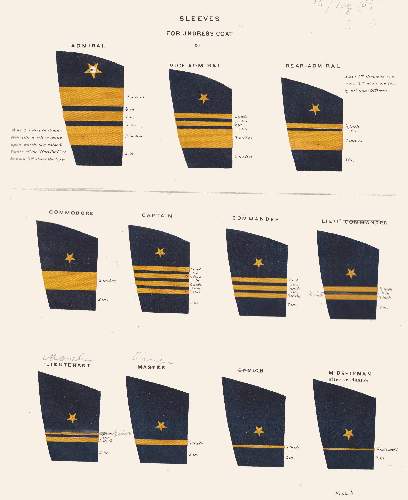 |
| Sleeve insignia begin to take modern form: Line officer insignia as illustrated in the 1869 Navy uniform regulations. A user has penciled in later changes. Author's collection. |
The gold lace sleeve stripes that are the most familiar indication of naval officers' rank were introduced to the U.S. Navy by the Uniform Regulation of 1852.1 At that time, there were three commissioned officer ranks indicated by three-quarter inch wide gold lace rank stripes: three for captain, two for commander, and a single stripe for lieutenant. The uniform cuffs had additional decoration of three small buttons at the rear, and a short vertical lace strip to the bottom of the cuff. The lowest officer rank, master, was indicated by three large cuff buttons rather than gold lace. The rank stripes of 1852 were still in use when the Civil War began, but with the rapid expansion of the navy in the next year there was soon a need to account for newly authorized ranks. In 18622 the system of three-quarter inch stripes was augmented by narrow quarter-inch braids, added to the existing stripes for the extra ranks. The ornamental cuff buttons and the vertical strip were eliminated.
In 1863,3 this system was replaced by a completely different scheme using only quarter-inch stripes, one added for each higher rank and separated into groups to avoid visual confusion. In addition, line officers added a one-inch diameter gold star above the rank stripes. Similar to the curl adopted by the Royal Navy in 1856, the star has continued to the present day. Though 1864 regulations specified that one ray of the star point down toward the rank stripes, for years it would be seen in either "point up" or "point down" configuration depending on the individual.
The all-narrow stripe system lasted a few years after the Civil War, with a couple of changes for the top ranks. In 18665 David G. Farragut's new rank of full admiral was denoted by an arrangement of two two-inch and a one-inch stripe. With an extra-large star bearing a medallion depicting his former flagship Hartford, Farragut's insignia measured over nine inches from top to bottom.
In March 18696 orders from the Secretary of the Navy introduced new sleeve insignia in half-inch and quarter-inch widths, similar to those adopted by the British Royal Navy in 1856, and basically the same as those used today. It would take a few years, however, for the arrangements to reach their present form. The system initially adopted could be seen as combining pairs of existing quarter-inch stripes into a single half-inch stripe, with odd numbers left as quarter-inch. Captains were indicated by three half-inch stripes and commanders by two half-inch and one quarter-inch. This only lasted a few months before captains' insignia was increased to four stripes and commanders' to three,7 likely in recognition of the Royal Navy insignia already in use. Though the insignia of one broad and three medium stripes had been introduced for the rank of admiral, the lone holder of this rank had the option of wearing the more elaborate 1866 insignia. David Dixon Porter succeeded to the navy's only full admiral position upon Farragut's death in 1870.
With other changes ordered in 18748 and finally in 1881,9 the insignia arrived at the form which remains in use today. The ranks of admiral and vice admiral lapsed in 1891 and 1890 respectively with the deaths of their holders, and the insignia were dropped from the 1897 regulations.11 In March 1899 the rank of admiral was revived for George Dewey, victorious commander at the Battle of Manila Bay. The Naval Personnel Act of the same month abolished the rank of commodore. When revised uniform regulations were published in May 1899,12 the sleeve rank insignia specified for an admiral were similar to those of 1866, but with narrowed spacing and the regular line officer star. The insignia for commodore were deleted.
Dewey's rank was titled "Admiral of the Navy" in the original legislation, but the nomination sent to the Senate had used the term "Admiral in the Navy,"13 and the Navy Register listed Dewey as "Admiral" in the same way it had Farragut and Porter.14 In 1903 a new nomination, retroactive to March 1899, was sent to the Senate, confirming that Dewey's rank title of "Admiral of the Navy" was distinct from that of the two earlier admirals.15 In the uniform regulations of 1905, the title "Admiral of the Navy" replaced "Admiral."16
As the U.S. Navy started to see itself as a world naval power in the early 1900s, there began to be some movement in the Navy Department and Congress toward re-introducing the higher ranks of admiral and vice admiral, equal to those in command of other nations' fleets.17 Perhaps in recognition of this possibility, the U. S. Navy uniform regulations of 191318 were the first to include both the rank of admiral and admiral of the navy, the admiral and vice admiral insignia returning to the regulations with the qualifying notation "Should Congress revive the grade." Admirals and vice admirals were, in fact, re-authorized by Congress in 1915. Commodore insignia also reappeared in the 1913 regulations, though the rank had been removed from the active list of the navy. The rank of admiral of the navy died with Admiral Dewey in 1917 and disappeared from the uniform regulations.
U.S. Navy officers entered the Second World War with the same sleeve insignia as authorized by the regulations of 1922.19 The 1922 and 1941 uniform regulations still covered the insignia for the unused rank of commodore, which was reintroduced in April 1943.20 The only change made during the war was to add a new rank, fleet admiral, at the very top. Considering the vastly increased size of the armed forces during the conflict and interactions with British forces which had ranks higher than admiral and general,21 Congress in 1944 created new "five-star" ranks.22 Again following British precedent, a fourth medium stripe was added to the admiral's insignia. Though worn by the fleet admirals in December 1944, soon after their promotion, the new five-star insignia were not officially added to the 1941 uniform regulations until January 1945.23
Though the pattern and sequence of officers' sleeve rank has not changed since 1945, there were some changes in the rank titles associated with the insignia in the 1980s. In 1980, the Defense Officer Personnel Management Act re-established a one-star rank for the pay grade O-7 in the navy, with the title of "commodore admiral."24 The insignia of commodore was once again put into use for the new rank. In 1982 the title was changed to simply "commodore" by the Department of Defense Authorization Act of 1982.25 In 1986 the title was changed again to "rear admiral (lower half)" by the Department of Defense Authorization Act of 198626 and has retained the historical commodore rank insignia to the present day.
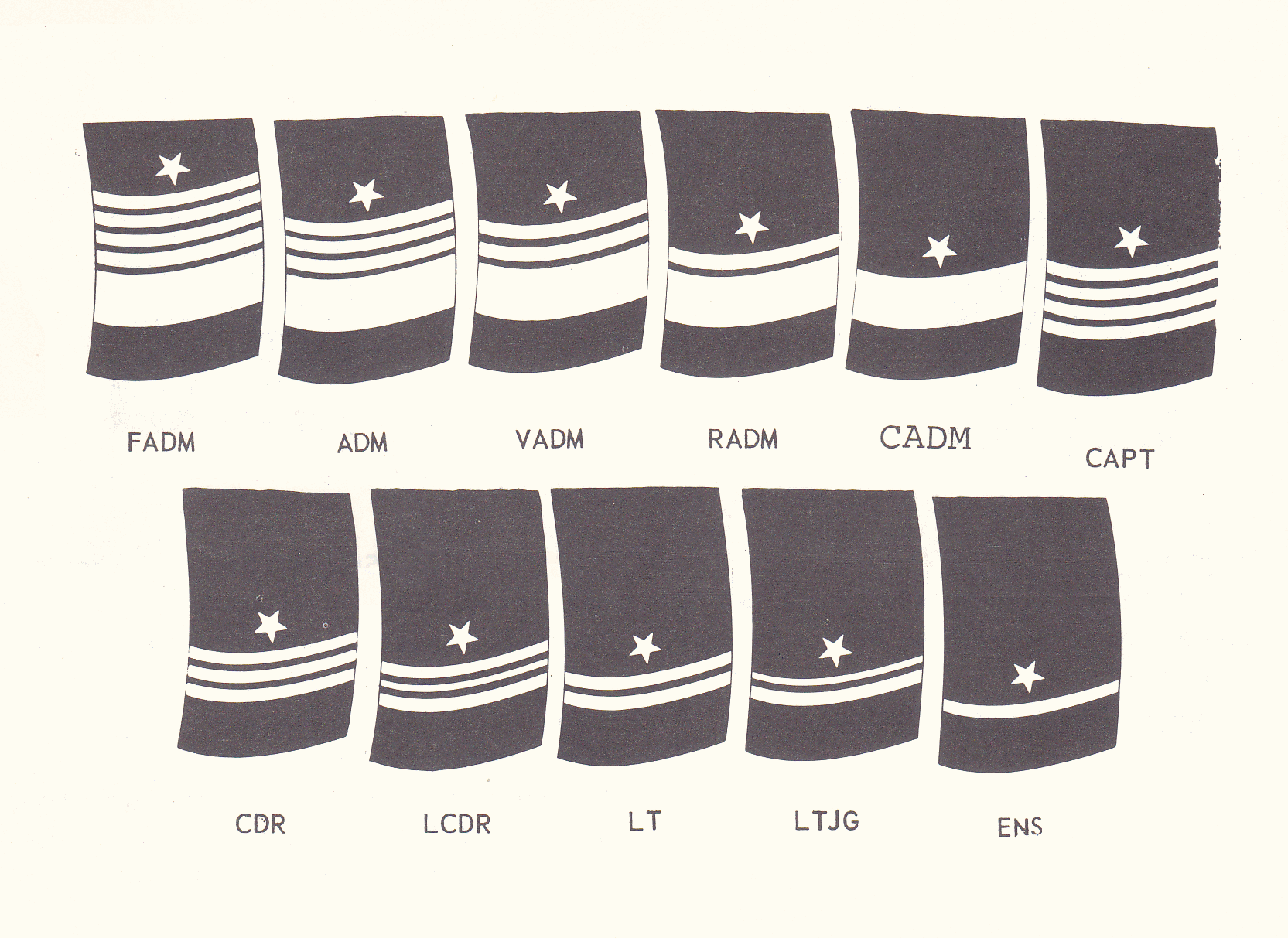 |
| An illustration from the 1981 uniform regulations, reflecting the short-lived grade of commodore admiral. Author's collection. |
The following table shows changes in insignia based on the date they appeared in or were removed from uniform regulations or official orders. The table shows admiral of the navy above fleet admiral due to its precedence over the later rank. Because of this, admiral of the navy appears two steps above admiral in 1913, but at the time it was only one step above.
This table does not include warrant officer grades. For the evolution of warrant insignia please see U.S. Navy Warrant Officer Insignia.
|
March 1852 [1] |
July 1862 [2] |
May 1863 [3] |
Jan. 1865 [4] |
Dec. 1866 [5] |
March 1869 [6] |
May 1869 [7] |
Nov. 1874 [8] |
Aug. 1881 [9] |
Nov. 1883 [10] |
July 1897 [11] |
May 1899 [12] |
Jan. 1905 [16] |
Jan. 1913 [18] |
Sept. 1922 [19] |
Jan. 1945 [23] |
|
| Admiral of the Navy | 
|

|
||||||||||||||
| Fleet Admiral | 
|
|||||||||||||||
| Admiral | 
| 
|

|

|

|

|

|

|

|
|||||||
| Vice Admiral |

|

|

|

|

|

|

|

|

|
|||||||
| Rear Admiral | 
|

|

|

|

|

|

|

|

|

|

|

|

|

|

|
|
|
Commodore (1862-1981, 1981-1985), Commodore Admiral (1980-1981), Rear Admiral (Lower Half) (1985-present) |

|

|

|

|

|

|

|

|

|

|

|

|

|
|||
|
July 1852 |
July 1862 |
May 1863 |
Jan. 1865 |
Dec. 1866 |
March 1869 |
May 1869 |
Nov. 1874 |
Aug. 1881 |
Nov. 1883 |
July 1897 |
May 1899 |
Jan. 1905 |
Jan. 1913 |
Sept. 1922 |
Jan. 1945 |
|
| Captain | 
|

|

|

|

|

|

|

|

|

|

|

|

|

|

|

|
| Commander | 
|

|

|

|

|

|

|

|

|

|

|

|

|

|

|

|
|
Lieutenant Commander |

|

|

|

|

|

|

|

|

|

|

|

|

|

|

|
|
| Lieutenant | 
|

|

|

|

|

|

|

|

|

|

|

|

|

|

|

|
|
Master (before March 3, 1883), Lieutenant (junior grade) (after March 3, 1883) |

|

|

|

|

|

|

|

|

|

|

|

|

|

|

|

|
| Ensign | 
|

|

|

|

|

|

|

|

|

|

|

|

|

|

|
|
| Ensign (junior grade) (created by legislation of March 3, 1883, abolished June 26, 1884) |

|
|||||||||||||||
|
Midshipman, graduated from the Naval Academy (before August 5, 1882, July 1, 1902–March 7, 1912) Naval Cadet, graduated from the Naval Academy (August 5 1882–July 1, 1902) |

|

|

|

| 
|

|

|

|
||||||||
|
July 1852 |
July 1862 |
May 1863 |
Jan. 1865 |
Dec. 1866 |
March 1869 |
May 1869 |
Nov. 1874 |
Aug. 1881 |
Nov. 1883 |
July 1897 |
May 1899 |
Jan. 1905 |
Jan. 1913 |
Sept. 1922 |
Jan. 1945 |
|
General Order 90 of 1869 prescribed gold oak leaf ornamentation for the full dress uniforms of rear admirals and above.27 To indicate rank, one, two or three rows of embroidered oak leaves were used on the sleeves in place of the gold lace stripes. Gold oak leaf embroidery also decorated the collar and the full dress sword belt. In 1873 the oak leaf ornamentation was eliminated for rear admirals, reverting to the standard stripes for full dress, though those with uniforms previously authorized were allowed to continue using them.28 The embroidered oak leaves were authorized for the vice admiral and admiral until their deaths.

|

|

|

|
| Admiral (Farragut) 1869-1870 |
Admiral (Porter) 1870-1891 |
Vice Admiral 1869-1890 |
Rear Admiral 1869-1873 |
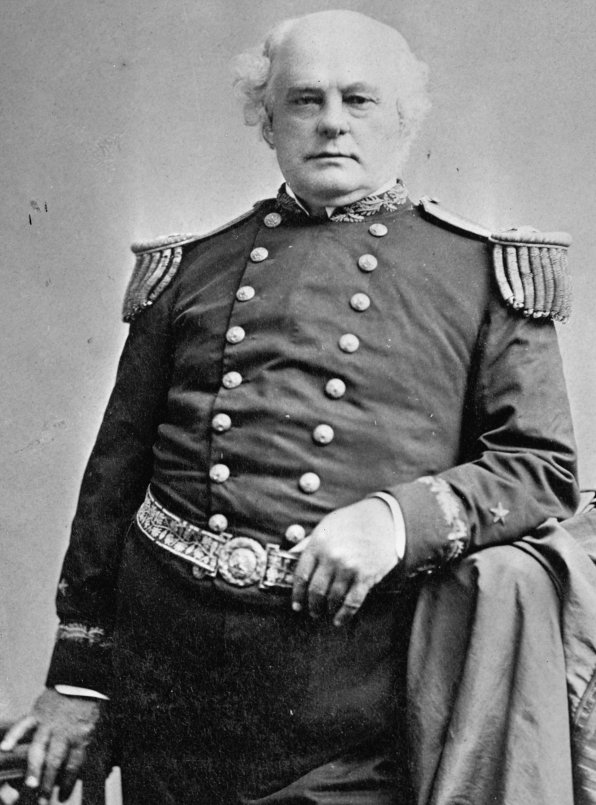
|
| Rear Admiral John Rodgers wearing the full dress uniform authorized by the uniform regulations of 1869, with oak leaf embroidery on the sleeves, collar and sword belt. Photo from the Library of Congress Prints and Photographs Online Catalog. |
The officer's blue service coat authorized in 1877 was trimmed around the edges with black mohair braid, and the sleeve rank was also shown in similar black braid, of the same widths and arrangement as the gold stripes of the full dress and frock coats.29 The line star and staff corps distinctions were not worn on the sleeves, but the coat also had collar devices to indicate rank and corps. The low-contrast black stripes were changed to gold in 1897.11
Similar black braid stripes, without corps devices, were worn on officers' overcoats beginning in 1883.10 In 1947 the overcoat sleeve stripes became optional,30 and were not included in the uniform regulations of that year.31

|

|

|

|

|

|

|
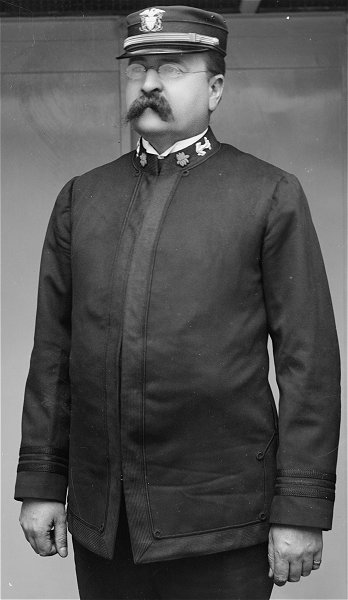
|
| A lieutenant commander in the blue service dress authorized before 1897, with black sleeve rank stripes. Photo from Library of Congress Prints and Photographs Online Catalog. |
In 1883 a white version of the service coat was authorized for officers to wear in warm weather.10 The cut was the same as the blue service coat, but in white cotton with white braid trim, including the sleeve rank stripes. Like the blue service coat, no star or corps indications were worn on the sleeve, but no collar devices were worn either. In 1897 the white rank braid was eliminated and officers were ordered to wear shoulder straps instead.11

|

|

|

|

|

|

|
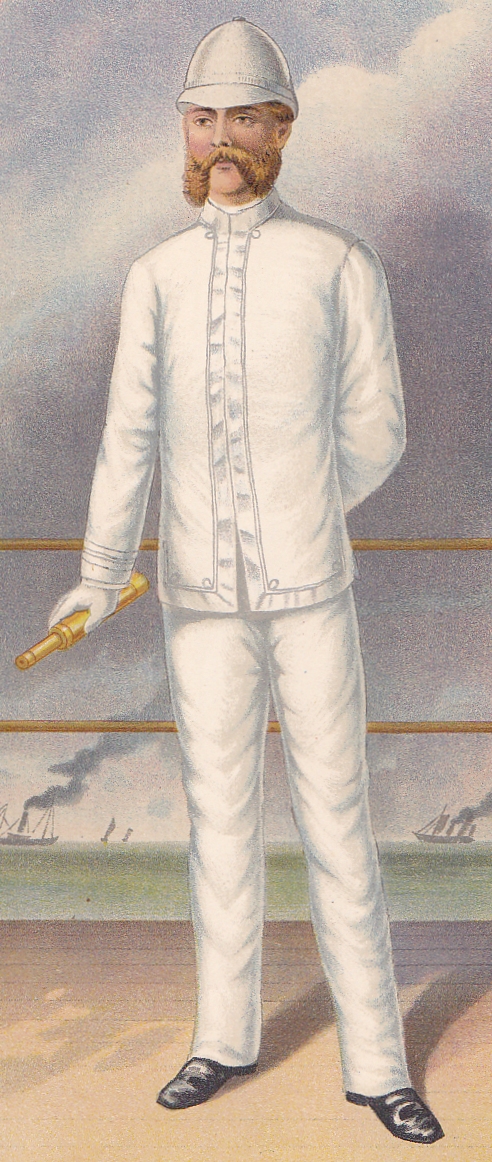
|
| The officer's white service uniform as illustrated in the Uniform Regulations of 1886. Author's collection. |
Working uniforms for aviation duty had been used during World War I, and new versions were authorized in 1925.32 Rank was indicated on the sleeve by black braid stripes and black embroidered corps insignia. The designation of the uniform was changed from "Aviation Winter Working" to "Aviation Working Green" in 1959. Though increasingly rare after the 1970s, the "greens" remained authorized for optional wear until 2010.33

|

|

|

|

|

|

|
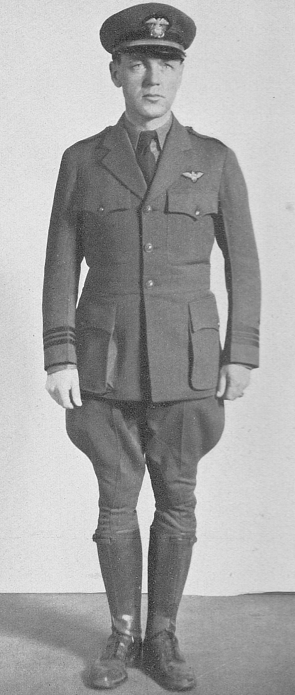
|
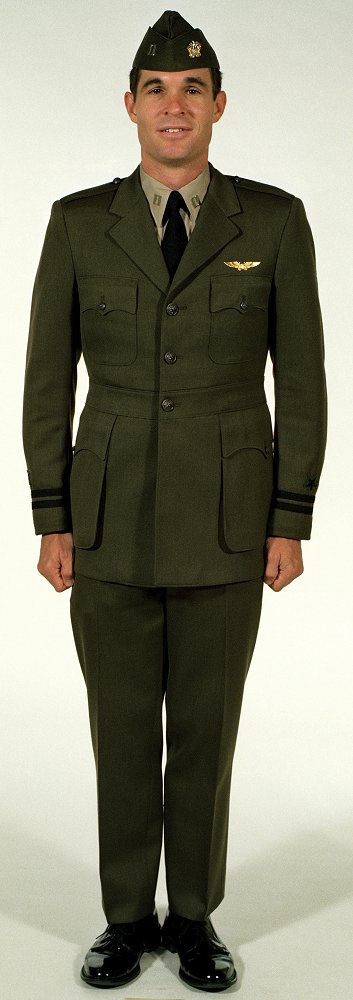
|
| The aviation working (winter) uniform as illustrated in U.S. Navy Uniform Regulations, 1925. Author's collection. | Aviation working green uniform, 1983. Photo from National Archives Online Public Access. |
A warm-weather version of the aviation working uniform was also authorized in 1925, made of khaki colored cotton.32 Like the winter green uniform, black braid rank stripes were worn on the sleeves. In 1931 the khaki uniform, with trousers only and black instead of brown shoes, was authorized as the "submarine working uniform."34 In March 1941 the khaki uniform was authorized for all officers. The sleeve braid made the khaki coat difficult to launder without dry cleaning, which was not an option at sea, so in April 1941 the black stripes were deleted in favor of the shoulder marks as worn on the white service dress uniform.35

|

|

|

|

|

|

|
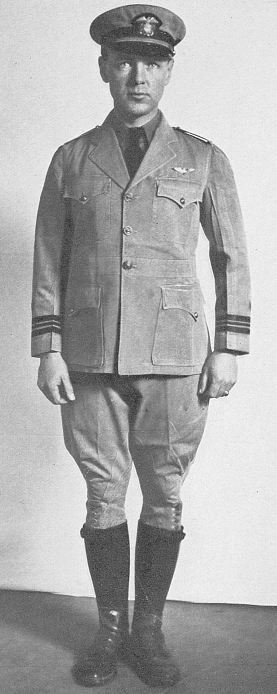
|
| The aviation working (summer) uniform as illustrated in U.S. Navy Uniform Regulations, 1925. Author's collection.. |
When Women's Reserve (WAVE) officers were authorized uniforms in 1942, their sleeve insignia was specified as light blue, known as "reserve blue," on blue coats.36 At first, officers who were not members of a staff corps wore no device above the stripes, but in September 1944 they were authorized to wear a blue line star.37 In 1951, the same gold stripes as male officers were specified for women's blue coats.38

|

|

|

|

|

|
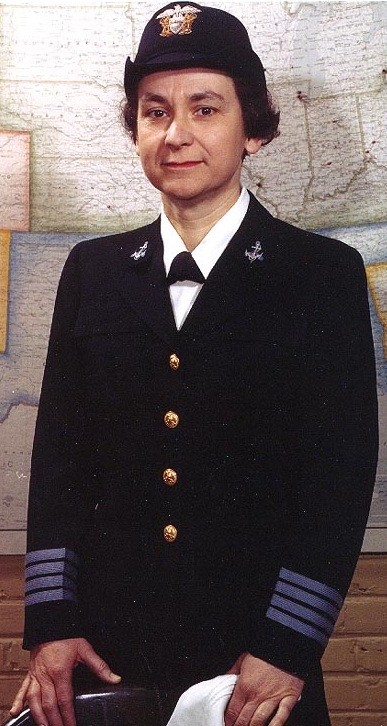
|
| The first Director of Women's Reserves, Captain Mildred McAfee, in blue service uniform before the blue star device was authorized in 1944. Photo from the Naval History and Heritage Command. |
On white uniforms, WAVE officers initially wore dark blue stripes and devices. In October 1943 a gray striped seersucker working uniform was authorized, which also used the dark blue stripes on the coat.36 As with blue WAVE uniforms, the star devices were not authorized until September 1944. In 1951, the gray seersucker coat was eliminated, and the dark blue stripes changed to white (see below).

|

|

|

|

|

|
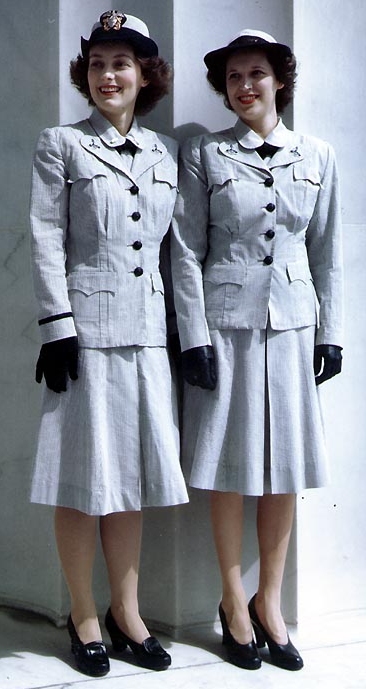
|
| Commissioned and enlisted WAVES wearing the gray working uniform, before the officers' blue star device was authorized in 1944. Photo from the Naval History and Heritage Command. |
The uniform regulations of 1951 authorized gold stripes identical to male officers for women's service dress blue coats. For women's service dress white, white braid sleeve stripes were specified with corps device embroidered in yellow silk or similar fiber.38

|

|

|

|

|

|

|
In 1961 Change Number 1 to the 1959 uniform regulations authorized gold sleeve stripes on women's white service coats in place of the white braid, with gold embroidered corps devices.39 In October 2015 it was announced that the women's white coat would be changed to a pattern similar to the men's version, with a standing collar and rank on shoulder boards. The new coat became mandatory January 1, 2020.40

|

|

|

|

|

|

|

|

|

|
In January 1963 Change Number 2 to the 1959 uniform regulations authorized dinner dress jacket uniforms for women officers.41 Unlike service dress uniforms, the women's jackets had the same sleeve ornamentation for all ranks: a one inch stripe in black velvet on the blue jacket and in white braid on the white jacket, with a gold corps device above. Rank was indicated by collar devices on the white dress shirt.

|

|
| Dinner dress blue and white jacket sleeve ornamentation for all ranks of female commissioned and warrant officers, 1963-1975. | |
In 1975, the uniform regulations specified the same gold stripes on the white jacket as on the white service coat.42

|
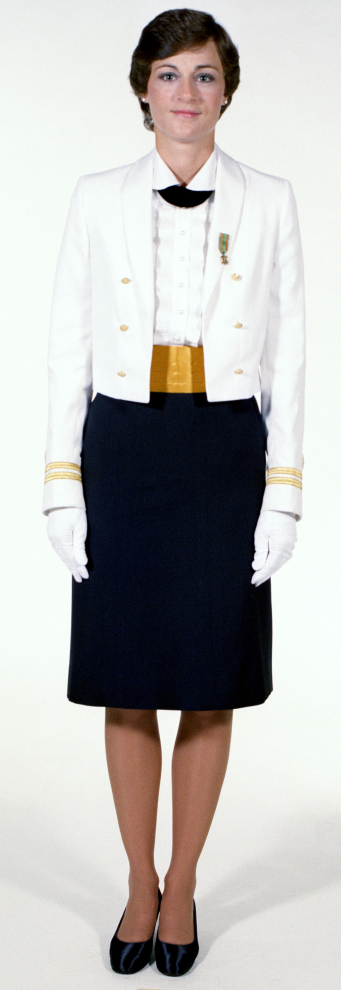
|
| Female officer in service dress white uniform, 1984. Photo from National Archives Online Public Access. | Female officer in dinner dress white jacket uniform, 1983. Photo from National Archives Online Public Access. |
Text and illustrations © 2013-2020, Justin T. Broderick.